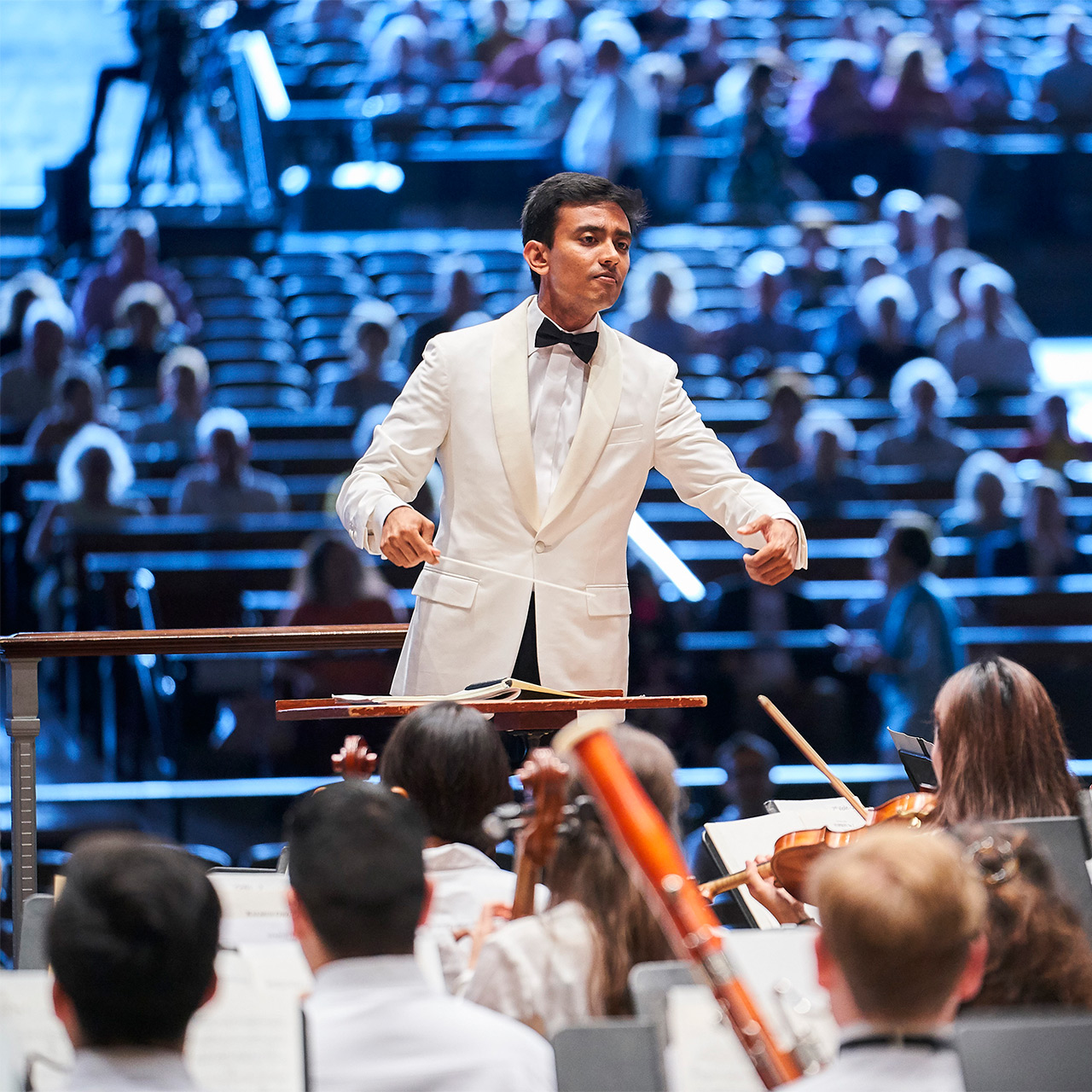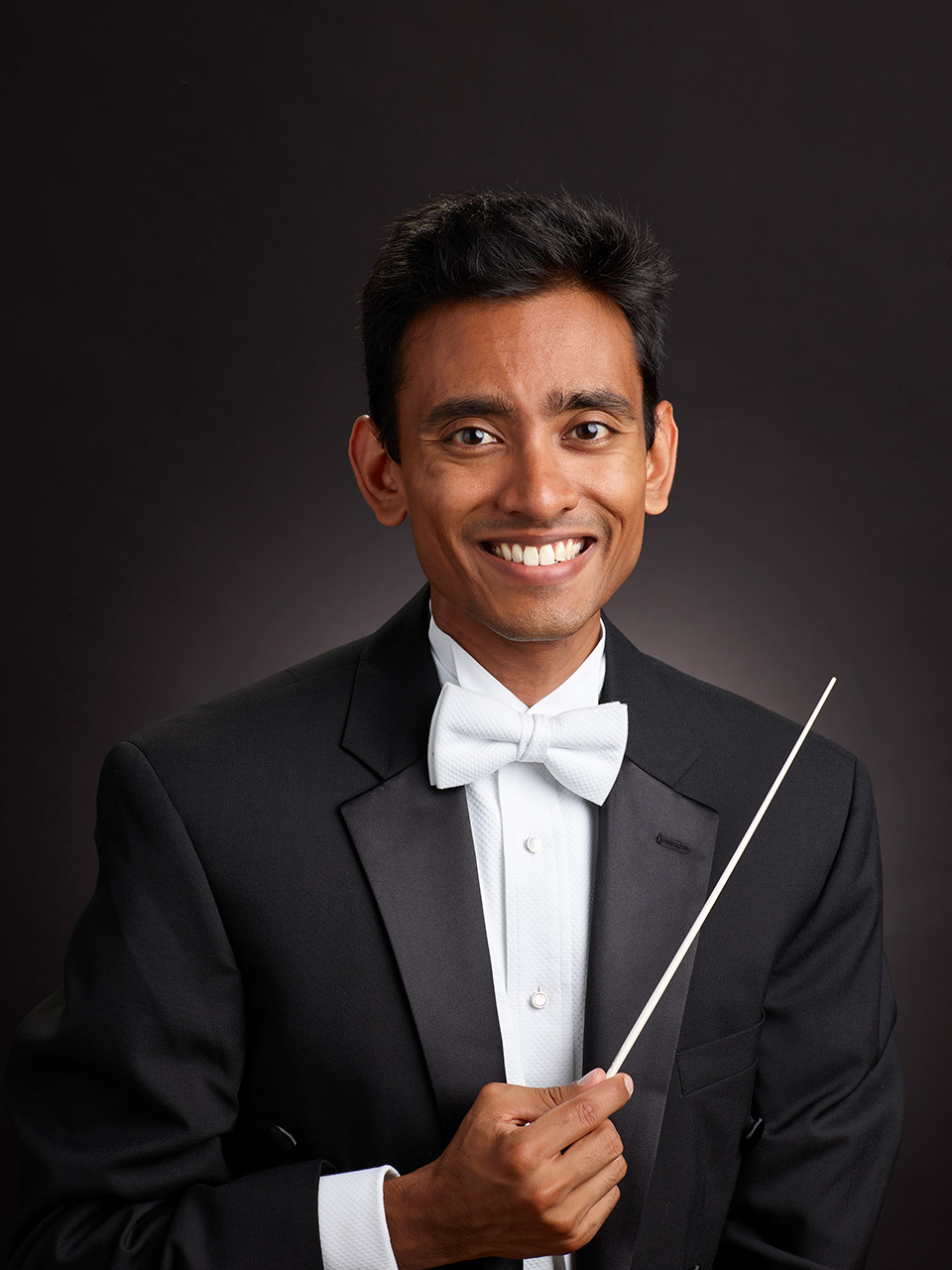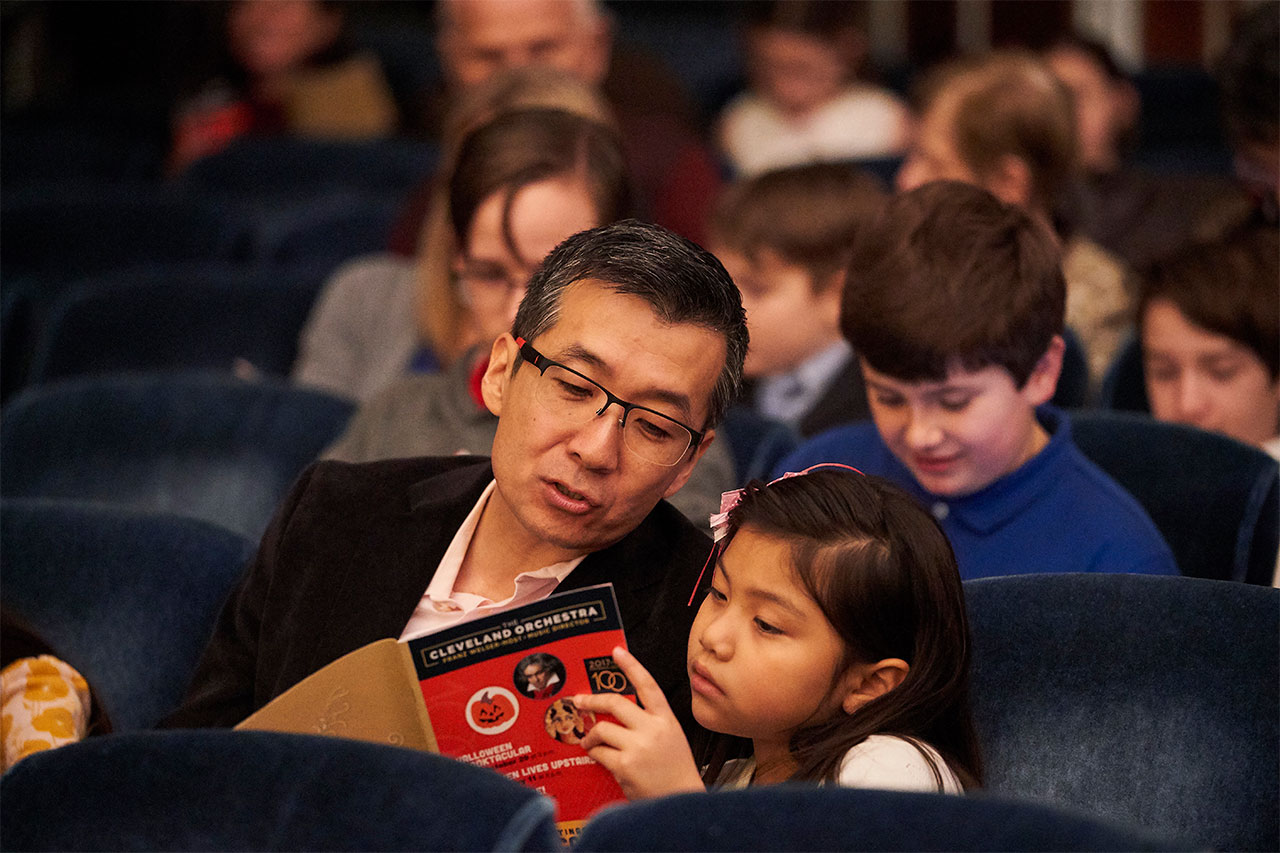
Program Notes Fanfare For the Common Man
This evening’s concert, which opens the 2022 Blossom Music Festival, brings together two works that surprise, intrigue, invigorate, and touch our hearts.
- July 2, 2022
- Blossom Music Center
- 2022 Blossom Music Festival
About the Music
Concert Overview
American composer Aaron Copland once said, “Contemporary music … is created to wake you up, not put you to sleep. It is meant to stir and excite you, to move you — it may even exhaust you. But isn't that the kind of stimulation you go to the theater for or read a book for? Why make an exception for music?
This evening’s concert, which opens the 2022 Blossom Music Festival, is no exception. This performance brings together two works that surprise, intrigue, invigorate, and touch our hearts.
The wild ride of Friedrich Gulda’s Concerto for Cello and Wind Orchestra zigzags from underground jazz club to the magisterial Austrian Alps to a final polka that seems suited for an Octoberfest bash. Gulda, .a concert pianist who gave acclaimed performances of Bach, Mozart, and Beethoven, was radically broad-minded in his musical tastes. He was even known to launch into improvised cadenzas during classical concerts that incorporated free jazz and rock and roll. This ethos is embedded into his Cello Concerto, which principal cellist Mark Kosower says “[this] piece is a forerunner of crossover music. Gulda is taking classical forms and in those forms he’s using rock, jazz, the cycle of the blues and combining them with Austrian folk music, and he also throws in references from Eastern musical traditions.”
Copland dedicated his Third Symphony to the memory of Natalie Koussevitzky, wife of the great conductor Serge who commissioned it in 1944. The composer spent much of the next two years toiling away at what is his largest and most ambitious work for orchestra. Infused with the optimism of the U.S. victory in World War II, it premiered in 1946 and notably features Copland’s Fanfare for the Common Man in the final movement. Serge Koussevitzky later gushed to Time magazine that the work was “the greatest American symphony — it goes from the heart to the heart.” It is undoubtedly music that stirs, excites, and moves us.
- Mark Kosower’s performance is sponsored by The Jean, Harry and Brenda Fuchs Family Foundation.
- Saturday evening’s concert is dedicated to The Seven Five Fund in recognition of its extraordinary generosity in support of The Cleveland Orchestra.

Concerto for Cello and Wind Orchestra by Friedrich Gulda
- Composed: 1980
- Duration: about 30 minutes
Movements
- Ouverture
- Idylle
- Cadenza
- Menuett
- Finale alla Marcia
Scored for: flute (doubling piccolo), 2 oboes, 2 clarinets, bassoon, 2 horns, 2 trumpets, trombone, tuba, percussion (drum kit, tambourine), guitar, 2 basses, and solo cell.
Like the Roman god Janus — who governed beginnings and endings, doorways and duality — Friedrich Gulda had two faces to show the world. The first was that of a virtuosic concert pianist in the great Austro-German tradition of Artur Schnabel and Rudolf Serkin. The second, an iconoclastic artist who tested the limits of every musical boundary around him.
As a pianist, he taught Martha Argerich, collaborated with Chick Corea, and introduced Mozart sonatas to techno clubs before handing the crowded dance floor over to his friend DJ Vertigo. And as a composer, he wrote variations on themes as motley as Johann Strauss waltzes, jazz standards, and The Doors' "Light My Fire." Employing both faces throughout his career, Gulda was a singular force of nature — a musical high priest equally devoted to the sonic possibilities of jazz and the sacred temple of European art music.
Born in Vienna in 1930, Gulda trained in the traditional path of a classical musician. He received his first piano lessons at age seven and entered the Vienna Music Academy at 12. After winning first prize in the Geneva International Pianists' Competition at 16, Gulda was thrust onto the global stage, giving some 140 recitals in three years, including his Carnegie Hall debut in 1950.
While in New York City for his Carnegie performance, Gulda trekked five blocks south along Broadway to a new underground venue that had become the talk of the town: Birdland Jazz Club. The performances he witnessed from Sarah Vaughan and Duke Ellington on the smoky Birdland stage would forever change the trajectory of his career.
Exhausted by his demanding concert schedule, Gulda hated the idea of a career dictated by classical music's rules and regulations. In his words, he didn't want to "fall into the routine of the modern concert pianist's life" or "ride the cheap triumphs of the Baroque bandwagon." So he submerged himself in the world of jazz and improv, making his debuts at Birdland and the Newport Jazz Festival in 1956, and launching his Eurojazz Orchestra and an improv academy in the '60s. In jazz, Gulda had found, "the only music of our day, the only modern, progressive music ... [an] absolute contrast to the pale, academic approach I had been taught."
Challenging those pale, academic norms would become Gulda's hallmark. His recital programs mixed foot-tapping Mozart with jazz and free improv. He abandoned the traditional concert dress of white tie and tails, instead choosing a signature uniform of casual black and a woven skullcap. (That's if he wore anything at all — for a 1980 performance at the Brucknerhaus in Linz, Gulda danced around the stage playing a wooden flute in the buff.) And in a move right out of Ziggy Stardust's playbook, Gulda released false news of his death in 1999. Days later, after confirming he was very much alive, he used the coverage to promote an upcoming concert as his "resurrection party."
All showmanship aside, Gulda's popularity in both the jazz and classical worlds was a testament to his skills as pianist and composer. The same approach he brought to Bach — described by one critic as "architecturally clear ... and often quite astonishing in its uncomplicated directness" — manifests in his compositions too, perhaps nowhere so colorfully as in the Cello Concerto.
Composed for Heinrich Schiff in 1980, the five movements of Gulda's concerto transport the listener through blues-rock, Austrian ländler, free improv, a courtly minuet, and a finale of bawdy, lederhosen-clad polka. Even the work's instrumentation could only have been devised by Gulda. Banishing the orchestra's string section, he instead merges the woodwinds and horns of 18th-century Viennese serenades, the bright punch of a big band brass section, and the electric guitar, bass, and drum set of a jazz combo.
The result is a work full of sonic trap doors and fun-house mirrors, with music both virtuosic and uncomplicated. It's a dizzying journey that leaves us happy to have been along for the ride.
The soloist launches the Ouverture with a propulsive, syncopated melody — a brisk prelude to the high-octane blues-rock groove set up by the jazz trio. But just as Gulda begins developing that one motive, we encounter our first trap door: a moment of silence, followed by a simple cadence in the winds and a swaying folk dance that evokes the sunlit summer landscape of Austria's Salzkammergut region. As is often the case with Gulda, this moment of pastoral peace doesn't last long. Dissonant snarls from muted brass plunge us back into the fever dream of the opening rock groove.
A gentle brass chorale sets the scene for Alpine Idylle, the golden warmth of French horns sharing with the soloist a soaring melody of unaffected simplicity. Oboes and clarinets playfully introduce a rollicking waltz theme, which the cello answers with a wistful, minor-key countermelody in its most expressive range. Woodwind scales, bubbling up like flutes of Sekt, Austria's beloved sparkling wine, lead us back to the opening chorale, where the burnished timbre of clarinets and bassoon add to the richness of the cello's song of longing.
The dramatic heart of this otherwise explosively upbeat concerto, the seven-minute Cadenza sees the soloist run a gamut of emotion — from quiet resignation and melancholic sighs to Shostakovichian levels of pathos. Here Gulda calls for two extended sections of free improv — one in which the soloist moves through different musical intervals in sinewy, serpentine fashion, the other a hushed display of the cello's ethereal harmonics.
From the moody Cadenza emerges the Menuett, a florid neo-Renaissance dance led by woodwinds and the quiet rustling of a tambourine. After the soloist takes up the opening theme, the flute introduces a languid second melody that glistens against gentle, silvery taps of the triangle. Following traditional dance form, the Menuett's opening tune returns, but instead of a full repeat of the material, Gulda sets another trap door for us, and the music suddenly vanishes into thin air …
What's on the other side of that silence? The jaunty oompahs of a beer-garden polka band, of course! Following the first blast of the Finale alla marcia's brassy bacchanal, the cello begins a wild dance of its own — an unceasing rush of sixteenth notes that fly up and down its four strings. A lyrical second melody momentarily calms the mood, but as we've already seen, Gulda can't restrain himself for long. The polka music doesn't relent. In fact, it becomes more strident, more insistent with each return, adding rowdy wails from the clarinets and piercing trills in the piccolo — that is, until another moment of quizzical silence from which a completely new mood emerges.
Against a trembling growl in the bass, the soloist and drummer playfully egg each other on. Fragments of the cello's rushing sixteenth-note melody are answered by insistent slaps of the high hat. The drummer adds snare, cymbal, and bass drum one by one, adding to the mystery. Dissonant chords from muted brass harken back to the Ouverture's blues-rock, ratcheting up the tension, making us believe the concerto will end in the same jazzy world in which it began.
But no — Gulda sends us through another of his trap doors, and we're back in the beer garden. The brass polka reigns supreme, propelling the cello into its final sprint and ending with a blast of wild, unadulterated joy.
— Michael Cirigliano II
Michael Cirigliano II is a freelance arts journalist and copywriter. He has written for Lincoln Center for the Performing Arts, the Oregon Symphony, the Metropolitan Museum of Art, and the Whitney Museum of American Art.

Symphony No. 3 by Aaron Copland
- Composed: 1944-46
- Duration: about 45 minutes
Movements
- Molto Moderato, with simple expression
- Allegro molto
- Andantino quasi allegretto
- Molto deliberato — Allegro risoluto
Scored for: 3 flutes, piccolo, 2 oboes, english horn, 3 clarinets, bass clarinet, 2 bassoons, contra-bassoon, 4 horns, 4 trumpets, 3 trombones, tuba, timpani, percussion (bass drum, snare drum, tenor drum, tam-tam, woodblock, slapstick, cymbals, triangle, ratchet, xylophone, glockenspiel, tubular bells, anvil, claves), 2 harps, celesta, piano, and strings.
Aaron Copland’s long life and busy career as composer and teacher left a legacy of great richness. He was quite quickly regarded as a leading figure among the many musicians of mid-century who were particularly concerned with the problem of defining a distinctive American voice in music. Even by 1900, the year of his birth, there had been many excellent American composers, but their training was European and their styles forged in the great German, Czech, and French traditions.
Copland studied in France with Nadia Boulanger and was much under the spell of Stravinsky, but he was nonetheless determined to fashion something new. In the sphere of abstract instrumental music such as sonatas and variations, he was clearly a pioneer with a considerable musical intellect, but it was in ballet and film that he was able to put an American label on his music and win a degree of popularity that lifted him to a most-favored rank. Raised in a Jewish community in Brooklyn, he was clearly not a natural son of the prairies, yet he managed to convey a sense of the great outdoors and of the nation’s wide spaciousness in the music he wrote for the ballets Billy the Kid and Appalachian Spring, as well as scores for films such as Of Mice and Men and The Red Pony.
During World War II, he broadened this national identity with patriotic pieces such as the Lincoln Portrait and Fanfare for the Common Man. So when he was asked by Serge Koussevitzky in 1944 to write something in memory of the conductor’s wife, Natalie Koussevitzky, Copland took the opportunity to combine his gift for large-scale formal thinking with his sharpened sense of national musical greatness in one big work. The end of the war was a moment for a strong positive gesture in music, and so he composed the largest symphonic work of his career using Fanfare for the Common Man as a rousing and recognizable basis for its triumphant finale. In fact, he became so absorbed in the composition of the symphony that he refused some tempting offers from Hollywood, including the opportunity to work with Alfred Hitchcock.
Copland wrote his First Symphony in 1924 and it had a prominent organ part, though he later revised it without the organ. His second symphony, the so-called “Short” Symphony, was lean and concise, with a modest orchestra. The Third Symphony, in contrast, adopted the full, traditional four-movement form and called for an immense orchestra whose full weight is not actually heard until the close of the finale. Copland’s delight in rhythmic intricacy is on display in all four movements. This dismayed some early critics, but it is more teasing for the eye as printed in the score than for the ear, since the listener readily engages with Copland’s lopsided and often joyful treatment of the beat.
The first movement spreads outwards from its broad, simple opening, gradually gathering pace and momentum, but never losing dignity and control. The composer’s harmonic style is based on diatonic chords from within the traditional major scale. He avoids clean common triads until the end of the movement, that is, because the final chord is a luminous chord of E major, a fundamental entity that has not been heard in the work until that point. The second movement is a scherzo, brisk and breezy, which reminds us strongly of Copland’s success as a ballet composer. It also evokes Shostakovich, but without any aggression. The central section is pastoral and relaxed, led off by the oboe, while the reprise of the scherzo is cut short by a noisy version of the pastoral theme, grandioso.
The slow third movement brings to mind Darius Milhaud’s assessment: “The melancholy simplicity of the Third Symphony’s themes is a direct expression of Copland’s own delicate sadness and sensitive heart.” This is not robust cowboy music but a quiet reflection on almost atonal themes, most of them pitched high in the orchestra. The central section is a surprise, returning to rhythmic, spiky music with a toy-shop character. There is no big climax but a gradual return to the pensive, desolate music of the opening. Once again, a pure major triad at the end is perfectly judged.
This leads directly into the finale, with the striding gestures of Fanfare for the Common Man prominently passed from one instrument to another. (Copland had created this fanfare as part of a wartime project of the Cincinnati Symphony Orchestra, which commissioned a series of patriotic fanfares to begin each concert during the 1942–43 season; Copland’s became an immediate and ongoing favorite with audiences and musicians.) In the symphony, the rhythmic complexity is constant, but the effect is uplifting as the orchestra rises to great heights of virtuosity. At one point, the oboe leads us like children to run free in the fields; at another we are rescued from an overpowering climax by the piccolo wandering off on its own. The fanfare is naturally the concluding gesture of a symphony that has ranged far and wide in feeling and expression and come to rest on a strongly positive note.
— Hugh Macdonald
Hugh Macdonald is the Avis H. Blewett Professor Emeritus of Music at Washington University in St. Louis. He has written books on Beethoven, Berlioz, Bizet, and Scriabin.
Featured Artists

Vinay Parameswaran Associate Conductor
Vinay Parameswaran joined The Cleveland Orchestra as assistant conductor with the 2017-18 season, and was promoted to associate conductor in 2021. In this role, he leads the Orchestra in several dozen concerts each season at Severance, Blossom Music Festival, and on tour. He also serves as music director of the Cleveland Orchestra Youth Orchestra.
Learn More
Mark Kosower Cello
Mark Kosower joined The Cleveland Orchestra as principal cello in 2010. Described as “a virtuoso of staggering prowess” by the Cleveland Plain Dealer, he is a consummate artist, equally known around the world as a recital and concerto soloist and chamber musician. Prior to his appointment in Cleveland, he was solo cellist of the Bamberg Symphony in Germany (2006–10).
Learn More
Want to keep reading?
Follow along with each performance at the 2022 Blossom Music Festival, and discover new program notes all summer.
Explore More Programs